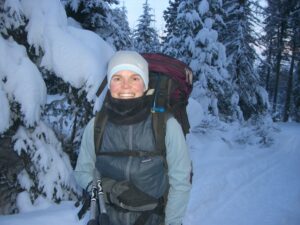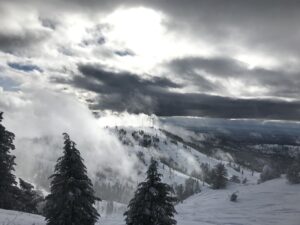I grew up in Colorado but didn’t get into skiing until I was in college in Durango. The local resort was named Purgatory, but the name officially changed to ‘Durango Mountain Resort’ in 2000 after new owners secured the purchase. This just didn’t feel the same to us locals, who liked the idea of skiing in a gorgeous area whose name meant the space between heaven and hell.
Resorts in Colorado and Idaho have enjoyed heavenly winters for decades, but what does the future hold for winter sports as we prepare for the continued impacts of climate change?

Idaho’s climate is changing. Temperatures have risen almost 2 degrees Fahrenheit since 1900. This may not seem like much, but it has equated to fiercer storms, increased intensity of wildfires, and importantly, a change in our water regimes, including snowpack.
Under projected climate changes, we will likely see increasing precipitation in the winter and early spring, mainly in the form of rain, as well as decreasing summer precipitation. An increase in rain on top of snow events is also likely, which is important to note for winter recreation and tourism at resorts like Schweitzer, where the bottom of the Stella Chairlift is only 3,900 feet in elevation. Rain-on-snow can also lead to more flooding as well as landslides and mudslides. In the past 40 years, our western states have seen snowfall decrease by 40%, which equates to about 35 fewer recreation days. This means our resorts are opening later in the season, and entire communities are feeling the financial impact of shorter winters.
Changes in our mountain snowpack not only affects winter recreation and tourism, which provides about $475 million in annual tax revenues and boosts our economy by nearly $4 billion, but agriculture, plants, and wildlife as well. In our waters, fish spawning can be disrupted when changes in snowmelt alter the timing and abundance of insects and streamflow. On land, certain types of trees rely on snow for insulation from freezing temperatures, and as seen with Laclede near Priest River, mills may need to be retooled to accept tree species that grow on drier sites. Bark beetles are thriving in these warmer temperatures, killing trees and providing fuel for wildfires. Along with having more fuel, warmer temperatures, drought, and earlier snowmelt are leading to longer and more intense fire seasons.

How did this happen? These changes in rising temperatures, the timing of snowmelt, and declining mountain snowpack are due to burning fossil fuels like gasoline, oil, and coal. When these fuels are burned for energy, manufacturing, and transportation, carbon dioxide (CO2) enters the atmosphere in ever increasing amounts. This builds up CO2 around the Earth, increasing the heat-trapping blanket and causing both air and water temperatures to warm.
Ski resorts around the country are taking steps to reduce their contribution to climate change, as well as find ways to adapt – after all, their business depends on it. Many are helping as Durango Mountain Resort did – by adding a shuttle bus to reduce gasoline usage. To maintain forests that convert CO2 to oxygen, some resorts are avoiding expanding their ski trails into undisturbed forest while simultaneously incorporating wildlife habitat and forest protection into their plans. These efforts should be applauded – and you can do so by telling your local resort that you support them protecting forests and environmentally-sensitive terrain, taking policy positions that support the environment by reducing traffic and emissions, and conserving water and energy. These efforts are becoming increasingly important to winter recreationists when choosing destinations, as they should.

Idaho’s winter recreation industry can play a leading role in protecting our winters and reducing harmful greenhouse gas emissions. If we are going to tackle climate change and ease its most dire impacts, we are going to need to work together to advance clean energy projects, accelerate the adoption of electric vehicles, and support Idaho’s decision makers to move along at a quicker pace for our climate.
Durango Mountain Resort is named Purgatory once again and pays homage to its roots. Their slogan now includes, “close to heaven, fun as hell”. If we are to protect Idaho’s winters and the places that feel like heaven, then we must act on climate change. Idaho’s winter recreation industry, outdoor recreation opportunities, and our quality of life depend on it.
For opportunities to stand up for Idaho’s climate, sign up for our Climate Campaign updates here.
To learn more about how climate change impacts winter recreation, join ICL, Winter Wildlands Alliance, and SnowSchool at our Winter Recreation Science Pub in Boise on February 9, from 5:30 – 7:30 pm!

